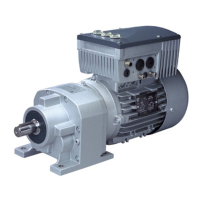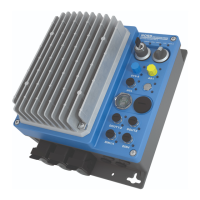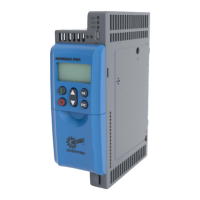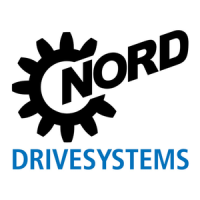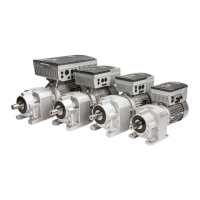
Do you have a question about the Nord Drivesystems NORDAC PRO and is the answer not in the manual?
| Category | DC Drives |
|---|---|
| Manufacturer | NORD Drivesystems |
| Series | NORDAC PRO |
| Enclosure rating | IP20 |
| Input voltage | 3 × 380 – 480 V |
| Output voltage | 0V to input voltage |
| Control type | Vector control |
| Protection features | Overcurrent, overvoltage, undervoltage, short circuit, overtemperature |
| Communication interfaces | Ethernet, CANopen, PROFIBUS |
| Cooling method | Push-through mounting |
| Ambient temperature range | -10°C to +40°C |
| Relative humidity | Up to 95% (non-condensing) |
| Mounting | Wall mounting |
Details on accessories for the frequency inverter, their availability, and specific documentation.
Overview of essential characteristics for different versions of the NORDAC PRO series.
Instructions for checking equipment immediately after delivery for transport damage.
Information on standard version components and a notice regarding defects from unapproved accessories.
General safety guidelines regarding handling, operation, and electrical connections.
Definition of qualified personnel and electricians for installation and commissioning.
Specifies correct usage for industrial/commercial systems, compliance with directives, and approved safety functions.
Guidelines for transport, storage, and installation, including ambient conditions.
Ensuring correct supply voltage, safe disconnection, and EMC-compliant installation.
Safety requirements during operation, ensuring covers remain closed and danger areas are secured.
Procedures for maintenance, repair, and disposal, including safety precautions.
Statement regarding the device's unsuitability for operation or maintenance in potentially explosive environments.
Information on UL and CSA approval status, including file numbers.
Explains how to identify device information from the type plate.
Details on mounting frequency inverters, including dimensions and wall mounting.
Information on braking resistors, their electrical data, dimensions, and monitoring.
Explanation of input and output chokes, their functions, and recommended usage criteria.
Details on connecting an external line filter (Mains filter SK HLD) for increased noise suppression.
General warnings and information regarding electrical connections, including safety precautions.
Diagrams and tables showing terminal assignments for supply and control cables based on inverter size.
Instructions for correct wiring to ensure safe operation and meet EMC directives.
Information on power connections including mains, motor, braking resistor, and DC coupling.
Details on connecting control units, including wiring simplification and connection data.
Information on connecting encoders, including cable colours and signal assignments for TTL/HTL.
Description of the RJ45 WAGO module for CANopen interface and signal implementation.
Summary of available option modules like ControlBox, customer units, and others.
Details on the SK TU5-CTR ControlBox for commissioning, configuration, and control.
How to add or subtract values using control boxes or ParameterBox.
Connecting multiple frequency inverters to a single parametrisation tool via CAN bus.
Default settings for standard applications and how to input motor data.
Guidance on selecting motor control modes like VFC, CFC, and their respective requirements.
Basic setup for controlling the inverter via digital and analogue inputs.
Information on using temperature sensors for optimizing current vector control.
Comprehensive overview of all important parameters categorized by function.
Configuration of operating displays, including selection of values and their meanings.
Detailed explanation of basic parameters like parameter sets, acceleration/deceleration times, and frequency limits.
Parameters for defining motor characteristics, including motor list, frequency, speed, current, and voltage.
Parameters related to motor control methods, encoder settings, and PID controller adjustments.
Configuration of analogue inputs and outputs, including functions and scaling.
Parameters for language, inverter naming, master function values, and bus communication settings.
Information on adjusting POSICON positioning control parameters, referencing manual BU 0610.
Display of actual operating status, faults, warnings, and software versions.
Indicates reasons for the device being in a 'Not Ready' or 'Start Disabled' state.
Messages generated when a defined limit is reached, which do not cause shutdown.
Messages causing the device to switch off, with options for fault reset (acknowledgement).
Explanation of LED indicators (DEV, BUS, USB) for diagnostic purposes.
How errors and warnings are displayed on the ControlBox, and how to acknowledge errors.
Information that the ParameterBox displays messages in plain text.
Detailed listing of error codes, their text, causes, and remedies.
General specifications including output frequency, overload capacity, and electrical isolation.
Detailed electrical specifications for 230 V and 400 V devices, including current, voltage, and fuses.
Illustration and explanation of how setpoint sources are processed for frequency inverters.
Description of the PI process controller for limiting output and scaling.
Information on EMC directives, standards, and device evaluation for interference immunity and emissions.
Explanation of reduced output current based on pulse frequency, time, mains voltage, and heat sink temperature.
Guidelines for operating with FI circuit breakers, considering leakage currents and types.
Information on energy efficiency improvements through automatic flux optimization (P219).
Details for standardizing typical setpoint and actual values related to various parameters.
Table describing how frequencies are processed for setpoint and actual value determination.
Guidance on maintenance-free operation, cleaning dusty environments, and long-term storage procedures.
Information for contacting technical support, device return procedures, and warranty.
List of abbreviations used in the manual with their corresponding meanings.
